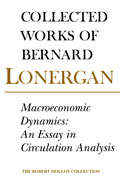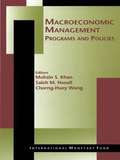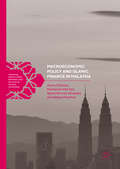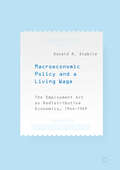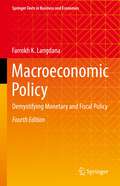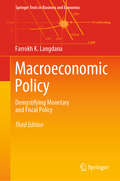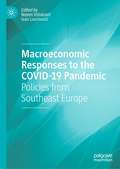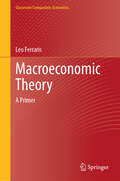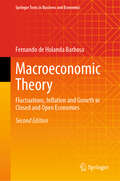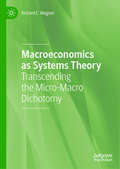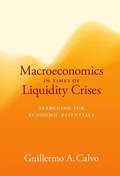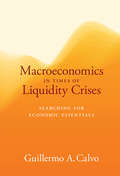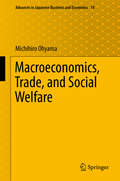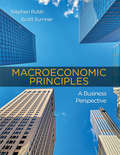- Table View
- List View
Macroeconomic Developments in the Baltics, Russia, and Other Countries of the Former Soviet Union, 1992-97
by Luis ValdiviesoA report from the International Monetary Fund.
Macroeconomic Dynamics: An Essay in Circulation Analysis, Volume 15
by Bernard Lonergan Charles Hefling Jr. Frederick Lawrence Patrick ByrneFew theologians in history have matched Bernard Lonergan's range of learning. Fewer still have written on the "dismal science" of economics. Rooted so solidly in the concerns of this world, economics is not a discipline we associate with the more rarified pursuit of theology. In this long-awaited volume, Lonergan demonstrates the short-sightedness of this view. This companion volume to For A New Political Economy (Collected Works of Bernard Lonergan, Volume 21) continues the work of bringing together the various elements of Lonergan's economic thought. His economic writings span forty years and represent one of the most important intellectual achievements of the twentieth century. They have previously been inaccessible outside of the Lonergan research community as the majority of them have not been formally published, and exist only as a group of unfinished essays and material for courses on economics taught by Lonergan. Lonergan's economic ideas track a different line of thought from that taken by contemporary economists. Macroeconomic Dynamics: An Essay in Circulation Analysis represents the economic thought of Lonergan at the end of his career. His analysis, while taking a fresh look at fundamental variables, breaks from centralist theory and practice towards a radically democratic perspective on surplus income and non-political control, and explores more fully the ideas introduced in For a New Political Economy. This work will be read not only by economists but also by liberation theologians, political theologians, and others inside and outside of religious organizations interested in social justice issues and alternative approaches to economics.
Macroeconomic Effects of EU Transfers in New Member States
by Céline Allard Nada Choueiri Susan Schadler Rachel Van ElkanA report from the International Monetary Fund.
Macroeconomic Effects of Pension Reform in Russia
by David HaunerA report from the International Monetary Fund.
Macroeconomic Management: Programs and Policies
by Mohsin S. Khan Saleh M. Nsouli Chorng-Huey WongEstablished in 1964, the IMF Institute provides training on macroeconomic management to officials of IMF member countries, on issues including: financial programming and policies, monetary and exchange operations, public finance, financial sector issues and macroeconomic statistics. This book considers the key issues addressed by the Institute's programme of economic management training, which policymakers need to consider when managing national economies.
Macroeconomic Paradigms and Economic Policy
by Giovanni Di Bartolomeo Nicola Acocella Andrew Hughes Hallett Acocella, Nicola and Di Bartolomeo, Giovanni and Hughes Hallett, AndrewThe recent financial crisis has demonstrated the dangers of ignoring the factors that led to previous crises, and the effectiveness of the policies designed to deal with them. Over time, these macroeconomic policies have evolved, oscillating between state intervention and a free-market approach. Following a story that runs from the pre-Great Depression era up until the Financial Crisis of 2007–11, this book reveals an intimate connection between new macroeconomic ideas and policies and the events in the real economy that inspired them. It does this in an accessible, easy-to-follow style, first by focusing on the developments of economic theories and policies, and then by concentrating on the design of domestic and international institutions and economic governance. Written by three leading experts on the history of economic policy, the book is ideal for graduates and undergraduates studying macroeconomics, monetary policy and the history of economic thought.
Macroeconomic Performance in a Globalising Economy
by Robert Anderton Geoff KennyThe process of globalisation has been ongoing for centuries, but few would doubt that it has accelerated and intensified in recent decades. This acceleration is evidenced as much by the strong synchronicity in the rapid transmission of financial crises starting in late 2007 as it is by the decade of almost unprecedented growth in international trade and financial market liberalisation that preceded it. This book shows how the international economy has become more connected via increased production, trade, capital flows and financial linkages. Using a variety of methodologies, including both panel econometrics and DSGE modelling, a team of experts from academia, central banks and the IMF examine how this increased globalisation has affected competitiveness, productivity, inflation and the labour market. This timely contribution to the globalisation literature provides a longer-term perspective while also evaluating some of the potential implications for policy makers, particularly from a European perspective.
Macroeconomic Policies and Poverty: Stylized Facts And An Overview Of Research (Routledge Studies in the Modern World Economy #No. 01/135)
by Catherine Pattillo Ashoka ModyIn this volume, world-renowned contributors, including Martin Ravallion, Michael Kremer and Robert Townsend, deal with the institutional characteristics of poverty resulting from the time pattern of aid, the nature of financial systems and the political economy of budgetary decisions. Going beyond the traditional literature on poverty, this original book deals with themes of broad interest to both scholars and policymakers in a clear yet technically sophisticated manner. Departing from conventional methods employed in poverty studies, these innovative essays enquire into the institutional characteristics of poverty, and using current case studies, they examine the crucial idea that periods of crises seriously affect poverty.
Macroeconomic Policies for Emerging and Developing Economies
by Partha Ray A VasudevanThis book examines the relevance of the concepts and hypotheses of macroeconomics in the contemporary world. It discusses the current debates on theory and practices of macroeconomic policies with a focus on developing economies emerging from the impact of Covid-19 pandemic. The volume advocates for a symbiotic relationship between macroeconomic policies and development strategies. It analyses several issues related to macroeconomic tools, which include openness, capital flows, exchange rate and financial strategies. It underscores the need to design a development strategy that accounts for the economic context of the countries concerned. Further, the book advocates for well-regulated macrofinancial policies promoting sustainable growth. It also provides recommendations to policy makers on formulating a sound and inclusive macroeconomic policy essential for financial stability. This book will be of interest to students and researchers of macroeconomics, public administration, development studies, management and policymaking. It will also be useful to economists, policymakers and journalists working on emerging and developing economies.
Macroeconomic Policy and Islamic Finance in Malaysia
by Abbas Mirakhor Syed Othman Alhabshi Azura Othman Norhanim Mat SariThis book offers an alternative framework for macroeconomic policy in Malaysia, derived from the universal principles of social justice espoused in the objectives of the Shariah. It attempts to holistically analyze issues related to public finance, which has been criticized for lack of transparency and justice in wealth distribution. This book explores these criticisms and discusses the principles of Islamic finance that may be applied to macroeconomic policymaking to create a better economy overall. It presents a case for a flat tax system, to make the economy more resilient to shocks, and financing methods that limit interest-rate-based debt contracts and allow greater risk sharing among the market participants on a broad scale. Using both qualitative and quantitative methods, this book models the Malaysian economy based on policies that apply the fundamental Islamic finance principle of risk sharing to demonstrate its benefits in spurring growth, promoting distributive justice, rendering the economy more stable, strengthening the potency of monetary policy, enhancing fiscal governance, and improving financial inclusion. The book will be of interest to students, policymakers, financial institutions, researchers, ministries of finance, central banks, securities commissions, and anyone interested in alternative economic paradigms.
Macroeconomic Policy and Poverty Reduction
by Brian Ames Ward Brown Shanta Devarajan Alejandro IzquierdoA report from the International Monetary Fund.
Macroeconomic Policy and a Living Wage: The Employment Act As Redistributive Economics, 1944-1969
by Donald R. StabileThis book offers a new interpretation of the Employment Act of 1946. It argues that in addition to Keynesian economics, the idea of a living wage was also part of the background leading up to the Employment Act. The Act mandated that the president prepare an Economic Report on the state of the economy and how to improve it, and the idea of a living wage was an essential issue in those Economic Reports for over two decades. The author argues that macroeconomic policy in the USA consisted of a dual approach of using a living wage to increase consumption with higher wages, and fiscal policy to create jobs and higher levels of consumption, therefore forming a hybrid system of redistributive economics. An important read for scholars of economic history, this book explores Roosevelt’s role in the debates over the Employment Act in the 1940s, and underlines how Truman’s Fair Deal, Kennedy’s New Frontier and Johnson’s Great Society all had the ultimate goal of a living wage, despite their variations of its definition and name.
Macroeconomic Policy in India Since the Global Financial Crisis: Trends, Policies and Challenges in Economic Revival Post-Covid (India Studies in Business and Economics)
by Sebastian MorrisThis book discusses the Indian economic crisis and brings out what went wrong and the correction necessary for getting the economy back to high growth trajectory, leading to economic transformation. To do so, the book covers trends in performance of Indian economy since the Global Financial Crisis to the COVID-19 effect, bringing out factors that have determined the same. The book questions the approach to macroeconomic policy of both the RBI and the government and brings out what it takes for macroeconomic policy to be supportive of high growth. It contains revealing contrasts with East Asia and China, although India has the same potential to grow with an expansion of manufacturing. Overall, it argues that macroeconomic policies (as much as structural, industrial, and trade policies) have been deficient and even good initiatives on the industrial policy and trade flounder for the lack of a strategic approach to macroeconomics. The book highlights the special opportunities present in an emerging economy with vast under and utilised labour and the macroeconomic policy initiatives that can take advantage of this key feature. It covers the macroeconomic data on growth using multiple indicators, then the external shocks and the internal policy measures/responses; besides, GVA/GDP, credit, exports, external transactions, interest and policy rates, yields, exchange rates, money, capital flows, indices of industrial sector, price indices and inflation, government expenditures, tax rates, fiscal deficits, market uncertainty measures to present a holistic picture of the economy and the shocks and policy actions that have followed. The book uses an innovative method of presentation and the consistency of the trends/stances of both monetary and fiscal policy using these large number of variables. It discusses the debate on overestimation of GDP/GVA growth estimates over the years from 2011-12 to about 2016-17 comprehensively. There is special coverage of GST with a comparison with China. Coverage also includes performance since the COVID-19 crisis again using a large number of indicators and an explanation for the same in terms of the limitations of the government’s initiatives to counteract. The book is a quick and ready reference of what has happened in macroeconomic terms to those interested in the relevant facts. It is of interest to international economists, policy analysts, and investors whose need to understand that the Indian economy in macroeconomic terms and in terms of the stances and penchant of the government and the RBI is of value.
Macroeconomic Policy: Demystifying Monetary and Fiscal Policy (Springer Texts in Business and Economics)
by Farrokh K. LangdanaThis book is an applications-oriented text designed for individuals who desire a hands-on approach to analyzing the effects of fiscal and monetary policies. Significantly updated for the fourth edition, the text provides an understanding of the global economy in the wake of the COVID crisis, discussing topics such as pandemic related supply and demand-side shocks, the role of Modern Monetary Theory (MMT) in financing COVID rescue plans, the effect of the US, India, Eurozone and China’s post-COVID economies on emerging and transitioning economies, and the resurgence of inflation. This edition includes deeper coverage on the issue of budget deficit sustainability and on trade wars, especially in a global context, and revisits the life cycles of speculative asset price (SAP) bubbles, especially in the housing markets and in SPACs. The fourth edition contains several brand-new cases and media articles that are carefully positioned to relate explicitly to theory, and to look ahead to and preempt global macro situations and polices in the years to come. MBA students and Executive MBA students who appreciate the importance of monetary and fiscal analysis will find this text to be right on target. Financial analysts and individual investors who need to strip away economic myths and jargon and systematically examine and understand the effects of macro policies on variables such as inflation, output, employment and interest rates, will also find the book extremely useful.
Macroeconomic Policy: Demystifying Monetary and Fiscal Policy (Springer Texts in Business and Economics)
by Farrokh K. LangdanaThis book is an applications-oriented text designed for individuals who desire a hands-on approach to analyzing the effects of fiscal and monetary policies. Significantly updated to provide an understanding of the post-financial crisis economy, the third edition covers the subprime crisis in detail, discussing monetary policies enacted in its wake, such as quantitative easing, tapering, carry trades, CMOs, and monetization. Even more globally oriented than previous editions, this volume links the Great Recession and US Monetary Policy to global hot capital flows and currency pegs. This edition also revisits the Eurozone in significant detail; discussing its history, its macroeconomic design challenges, and its present imperiled state, in the context of global macropolicy. Finally, this volume analyzes the "China syndrome" and explores the effects of slower trend growth in China on the rest of the world. India, with its different—almost supply-side—approach to macropolicy is also studied in detail. The third edition contains several brand-new cases and media articles that are carefully positioned to relate explicitly to theory, and to look ahead to and preempt global macro situations and polices in the years to come. MBA students and Executive MBA students who appreciate the importance of monetary and fiscal analysis will find this text to be right on target. Financial analysts and individual investors who need to strip away economic myths and jargon and systematically examine and understand the effects of macro policies on variables such as inflation, output, employment and interest rates, will also find the book extremely useful.
Macroeconomic Responses to Terms-of-Trade Shocks: A Framework for Policy Analysis for the Argentine Economy
by Pelin BerkmenA report from the International Monetary Fund.
Macroeconomic Responses to the COVID-19 Pandemic: Policies from Southeast Europe
by Neven Vidaković Ivan LovrinovićThis book examines economic policies utilized within Southeast Europe in response to the COVID-19 pandemic. Covering countries both within and outside the European Union, the human and economic cost of the pandemic is calculated using macroeconomic models from a short and longer term perspective. The economic policies used during the pandemic are analyzed, alongside crisis management approaches, to highlight the effectiveness of monetary policy, fiscal policies and potential future economic solutions for the post COVID-19 period. This book aims to provide policy recommendations based on findings from Southeast Europe. It is relevant to researchers and policymakers involved in economic policy and the political economy, as well as anyone interested in the responses to the COVID-19 pandemic.
Macroeconomic Theory: A Primer (Classroom Companion: Economics)
by Leo FerrarisThis book offers a comprehensive introduction to modern macroeconomic theory, bridging foundational concepts with contemporary applications. It begins by exploring the core macroeconomic model featuring rational agents and competitive markets—the cornerstone for analyzing business cycles, economic growth, and asset pricing. From there, it transitions to more complex frameworks, including models that incorporate market imperfections and strategic interactions, crucial for understanding liquidity challenges and financial crises. Designed as a primer, this text explains the theoretical foundations of modern macroeconomics in an accessible way, without relying on advanced recursive techniques.
Macroeconomic Theory: Fluctuations, Inflation and Growth in Closed and Open Economies (Springer Texts in Business and Economics)
by Fernando de BarbosaMacroeconomics is the application of economic theory to the study of the economy’s growth, cycle and price-level determination. Macroeconomics takes account of stylized facts observed in the real world and builds theoretical frameworks to explain such facts. Economic growth is a stylized fact of market economies, since England’s nineteenth-century industrial revolution. Until then, poverty was a common good for humanity. Economic growth consists in the persistent, smooth and sustained increase of per-capita income. A market economy shows periods of expanding and contracting economic activity. This phenomenon is the economic cycle. The price of money is the amount of goods bought with one unit of money, in other words, the inverse of the price level. Determination of the price level, or the value of money, is a fascinating subject in a fiat money economy. Revised and updated, the second edition introduces a number of new topics, including the New Keynesian IS Curve, Real BusinessCycles, and the Consumption Asset Pricing Model, as well as updated end-of-chapter exercises.
Macroeconomic Variables And Security Prices In India During The Liberalized Period
by Tarak Nath SahuThe liberalization of the Indian economy and consequent strengthening of the relationship between the Indian financial system and the rest of the world has made India more vulnerable to macro issues. This book provides a comprehensive analysis of the dynamic relationship between macroeconomic variables and stock prices in India. A wide range of statistical models are used to estimate and interpret the relationships between Indian stock prices and eleven macroeconomic variables during the liberalized period. While the author finds that the Indian stock market is sensitive to changes in macroeconomic fundamentals in the long run, in the short run only a few macroeconomic variables (such as consumer price index, foreign trade, and exchange rate) affect stock prices. The study also observes that the Indian stock market is approaching informational inefficiency in the long run. Research findings and policy implications discussed here provide insight into other emerging economies as well.
Macroeconomics as Systems Theory: Transcending the Micro-Macro Dichotomy
by Richard E. WagnerThis book examines macroeconomic theory from an analytical framework provided by theories of complex systems, in contrast to conventional theories founded on aggregation. The resulting difference in analytical perspectives is huge: the macro level of society is not pursued through aggregation over micro entities. To the contrary, the micro-macro relation is treated as one of parts-to-whole, and this relation is approached from within an ecological scheme of thought. A society is a complex ecology of plans. That ecology, however, is not reducible to a single plan. Conventional macro theory presents a national economy as a collection of such aggregate variables as output, employment, investment, and a price level, and seeks to develop theoretical relationships among those variables. In contrast, the social-theoretic approach to macro or social theory in this book treats the standard macro variables as having been shaped through social institutions, conventions, and processes that in turn are generated through interaction among economizing persons. The object denoted as macro is thus of a higher order of complexity than the object denoted as micro.
Macroeconomics in Times of Liquidity Crises: Searching for Economic Essentials
by Guillermo A. CalvoSince the subprime mortgage crisis that began in 2007, advanced economies have felt a nagging sense of insecurity. In parallel, the profession has witnessed phenomena that are alien to mainstream macroeconomic models. Financial crises are systemic, occurring simultaneously in different economies. In this book, Guillermo Calvo focuses on liquidity factors as a commonality in financial crises. Specifically, he examines the role of "liquidity crunch" in triggering crises. He also identifies a fundamental (but overlooked) idea in Keynes's General Theory, termed by Calvo the price theory of money, to rationalize the resiliency of the U.S. dollar when other dollar-backed assets suffered a devastating liquidity crunch.Calvo shows that a sharp focus on liquidity reveals some characteristics of liquid assets that are easy to miss otherwise. He argues for liquidity's centrality, presenting what he calls the Liquidity Approach. He shows that simple extensions of standard monetary models help rationalize the implications of the liquidity crunch, and then examines slightly more technical models that highlight liquidity issues. He explores the empirical effects of liquidity crunch by studying systemic sudden stops (of capital inflows), presuming that they are triggered by liquidity crunch-type phenomena.
Macroeconomics in Times of Liquidity Crises: Searching for Economic Essentials (Ohlin Lectures)
by Guillermo A. CalvoAn examination of Liquidity Crunch in triggering and characterizing financial crises.Since the subprime mortgage crisis that began in 2007, advanced economies have felt a nagging sense of insecurity. In parallel, the profession has witnessed phenomena that are alien to mainstream macroeconomic models. Financial crises are systemic, occurring simultaneously in different economies. In this book, Guillermo Calvo focuses on liquidity factors as a commonality in financial crises. Specifically, he examines the role of “liquidity crunch” in triggering crises. He also identifies a fundamental (but overlooked) idea in Keynes's General Theory, termed by Calvo the price theory of money, to rationalize the resiliency of the U.S. dollar when other dollar-backed assets suffered a devastating liquidity crunch.Calvo shows that a sharp focus on liquidity reveals some characteristics of liquid assets that are easy to miss otherwise. He argues for liquidity's centrality, presenting what he calls the Liquidity Approach. He shows that simple extensions of standard monetary models help rationalize the implications of the liquidity crunch, and then examines slightly more technical models that highlight liquidity issues. He explores the empirical effects of liquidity crunch by studying systemic sudden stops (of capital inflows), presuming that they are triggered by liquidity crunch-type phenomena.
Macroeconomics, Trade, and Social Welfare
by Michihiro OhyamaThis book develops new, original methods of welfare comparison and comparative dynamics between distinct and discretely positioned (rather than continuously related) socioeconomic situations. These methods are not only realistic but also extremely relevant to serious economic problems. Using them, the book sheds illuminating new light on the theoretical analysis of Keynesian economics and other important issues of political economy. For instance, it shows that the principle of effective demand applies exactly as Keynes put it to the unemployment equilibrium in the short run. It also shows that the equilibrium may change along the expansion path as the government chooses to vary its expenditure to maximize national welfare. The same methods are effectively employed theoretically to investigate modern trade policy issues such as gains from trade, the theory of tariffs, free trade agreements, and the role of the WTO. Those methods are also used to study the welfare and efficiency of various socioeconomic situations.
Macroeconomics: Macroeconomics And Social Policy In Memory Of William S. Vickrey
by Rubb SumnerCreated specifically for the economics course as taught in business schools, Economic Principles: A Business Perspective covers the fundamentals of economics in the context of today's globalized business world, with strong examples, integrated technology, and practical pedagogy. <P><P>Integrated business and policy briefs, in-depth case studies, chapter-ending business applications, thoroughly explained graphs and a battery of simple but useful learning tools support the intersection of theory and practice. <P><P>It's accompanied by a robust media component, SaplingPlus, which combines Sapling's acclaimed online homework with a complete e-book and all interactive features for the text.

